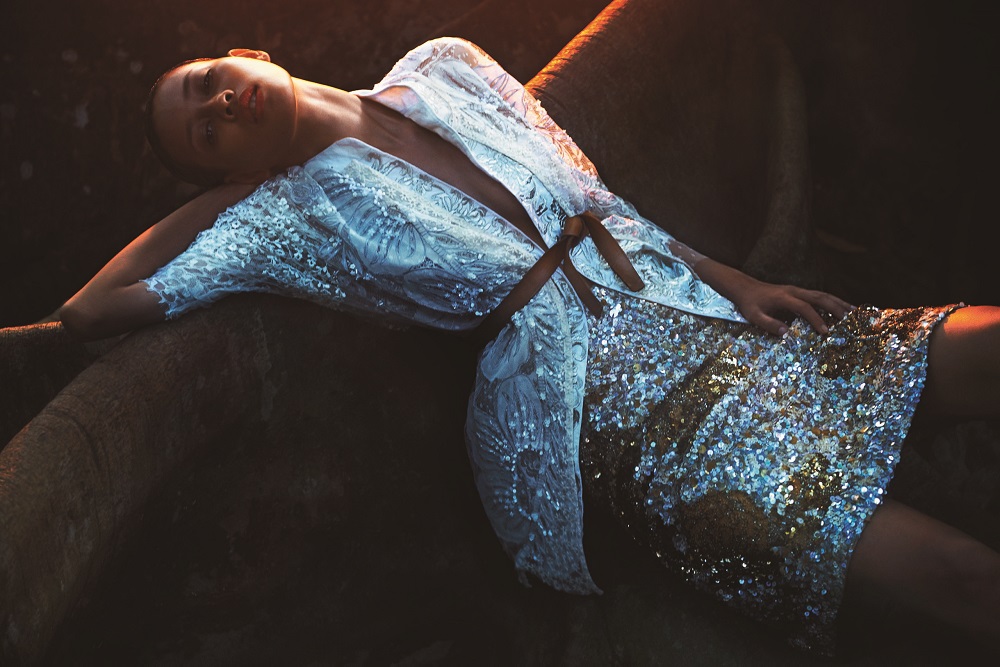Biyan book rekindles my admiration to creative genius of Biyan Wanaatmadja, one of the top Indonesian fashion designers. Rich with humble back story and visual delights, this book is a must-have for fashion lovers. Featured photo: Top – Spring-Summer 2014 collection, Bali. Skirt – Spring-Summer 2010 collection, Bali. Photograph by Stefan Khoo / Courtesy of Rizzoli New York.
When I was growing up in Jakarta, weekend trips to the shopping mall (in Kelapa Gading area) were almost customary. Exploring the multiple floors of Sogo, the Japanese department store chain, was one of our favorite ways for window shopping. Going up Sogo’s escalator was how I first encountered BIYAN designs. A cluster of shiny white mannequins clad in his intricate designs were the constant silent greeters in front of the ascending escalator towards the Women’s Designers floor. They looked beautiful, draped in pastel colors with pretty embroideries, flowing and delicate. My mother and I would marvel at them sometimes, but always left after glancing at the price tags. Even so, for my much younger self who had yet to discover fashion, his sense of design lingers.
[shashin type=”photo” id=”23170″ size=”medium” columns=”max” order=”user” caption=”y” position=”left”]
Biyan Wanaatmadja is one of the most highly regarded Indonesian fashion designer. He has the design genius of translating Indonesia’s rich heritage into etherial and elegant high fashion creations. BIYAN, his first clothing line that I encountered in Kelapa Gading Mall, began in 1984. His diffusion line STUDIO 133 BIYAN followed suit in 1985, trailed by the urban street wear line (X)S.M.L. in 1999 and BIYAN Bride in 2005.
For me, this Biyan book allows me to rediscover that lingering attraction I had with BIYAN designs when I was little. The first part of the book is a story of his beginnings, how he got to fashion, his current lifestyle in Indonesia, and his design philosophy. It is effectively told as an interview format with Natasha Fraser-Cavassoni, the author of Sam Spiegel, Tino Zervudachi: A Portfolio, and Dior Glamour.
It’s a fascinating read of how a Chinese Indonesian born in Surabaya went studying abroad in Germany first for becoming a dentist, then turned to fashion in 1975 after his father passed away. How he studied professional pattern making at Müller & Sohn before going to London College of Fashion and having tutors such as Stephen Worth and Michael Talboys before returning to Indonesia to launch BIYAN. Or that he likes to collect beautifully crafted necklaces from various places in Indonesia and how they inspire him to display both beautiful craftsmanship and people’s emotions behind it.
[shashin type=”photo” id=”23165,23162″ size=”xlarge” columns=”max” order=”user” caption=”y” position=”center”]
Biyan’s creations are always special, great exhibitions of diverse traditional crafts – batik, ikat, weaving, hand embroidery – first inspired by his grandmother’s Peranakan style (a cultural cross between Chinese and Indonesian; usually traditional, simple shapes with white-on-white embroidery or pastel on white). However, this book offers the human side of the BIYAN brand. He treasures exquisite workmanship (he likes this word because it implies a process), experiences a mix of excitement, curiosity, anxiety before each fashion show since his debut in 1988, and he values balance and emotion much more than perfection.
[shashin type=”photo” id=”23169,23163″ size=”xlarge” columns=”max” order=”user” caption=”y” position=”center”]
From the interview, the book’s storytelling progresses to visual wonders that implore emotional meditation. Each of the pages are filled with images of Biyan’s exquisite shots from his past collections. Elaborate embroidery, his signature element is displayed generously, implying the workmanship behind each piece.
Classic and sophisticated tailoring gives birth to feminine looks that are the key elements to fashion fairy-tale setup on his photoshoots. Biyan attributes this heavily to his collaborator Marc Ascoli, who is also the art director Jil Sander, Yohji Yamamoto, and Chloé, among others.
[shashin type=”photo” id=”23167,23166″ size=”xlarge” columns=”max” order=”user” caption=”y” position=”center”]
This book is a prelude to Biyan house’s 30th anniversary, and I hope many more fashion lovers find this treasure. As you go through the book, you will feel the soul of his design. Romantic, enchanting, classic, modern, elegant, refined, sophisticated…there are many more adjectives to describe Biyan Wanaatmadja’s creations. Deep inside, I’m very proud that he is Indonesian. What a fashion treasure Indonesia has in Biyan!
[shashin type=”photo” id=”23164,23168″ size=”xlarge” columns=”max” order=”user” caption=”y” position=”center”]
Now that I’m starting to have better appreciation of Biyan’s designs thanks to this book, I hope to one day own a piece of his workmanship to treasure forever. I hope that day will come soon.
Thanks for reading; until next time,
Musank
Photos by Davy Linggar and Stefan Khoo for Biyan / Courtesy of Rizzoli New York.
I may earn a small commission for my endorsement, recommendation, testimonial, and/or link to any products or services from this website. Thank you for your support!

